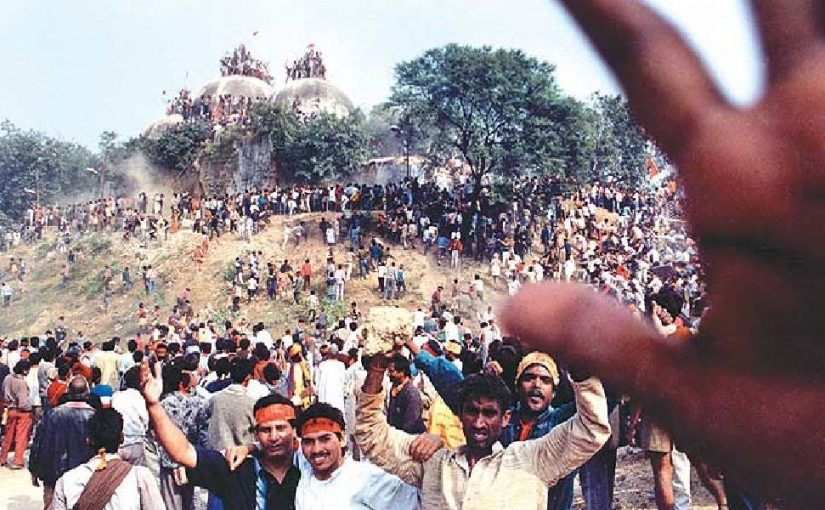Images of newspaper clippings with headline “Babri Masjid demolished, Centre sacks Kalyan Govt”, and one quoting former Prime Minister Atal Bihari Vajpayee as saying “Ayodhya BJP’s worst miscalculation” have now been deleted, The Indian Express reported.
The updated NCERT Class 12 Political Science textbook, released last week, has removed Babri Masjid’s name and has called it a “three-dome structure,”The Indian Express reported. The revised textbook also cut down the Ayodhya section from four to two pages and deleted multiple references of the mosque’s demolition.
Some of the significant details of the Ayodhya episode that were deleted include the L.K.Advani-led BJP’s Rath Yatra to mobilise supporters for the Ram Janmabhoomi movement, Kar Sevaks’ crucial role in bringing down the Babri Masjid, communal riots in the aftermath of the mosque’s demolition on December 6, 1992, President’s rule in BJP-ruled states, and BJP’s “regret over the happenings in Ayodhya”.
IE had earlier reported that the revised political science textbook also removed at least three references to the demolition and painted the newly-constructed Ram Temple in Ayodhya as a culmination of “centuries old legal and political dispute” that was resolved by the Supreme Court in 2019. The previous version contained the sequence of events from the opening of the locks in 1986 to subsequent political mobilisation on both sides that altered the course of India’s politics.
The revised textbook is also a new version of Ayodhya’s history. While the old textbook refers to Mir Baqi as the one who built the Babri Masjid in the 16th century, the new textbook says that the “three-dome structure” was built at the site of Shri Ram’s birthplace, and that the structure had “visible displays of Hindu symbols and relics in its interior as well as its exterior portions”.
Replacing the sequence of events since 1986 in the previous version, the new textbook says, “In 1986, the situation regarding the three-dome structure took a significant turn when the Faizabad (now Ayodhya) district court ruled to unlock the structure, allowing people to worship there. The dispute had been going on for many decades as it was believed that the three-dome structure was built at Shri Ram’s birthplace after demolition of a temple. However, although Shilaanyas for the temple was done, further construction remained prohibited. The Hindu community felt that their concerns related to the birth place of Shri Ram were overlooked, while the Muslim community sought assurance of their possession over the structure. Subsequently, tensions heightened between both communities over ownership rights, resulting in numerous disputes and legal conflicts. Both communities desired a fair resolution to the longstanding issue. In 1992, following the demolition of the structure, some critics contended that it presented a substantial challenge to the principles of Indian democracy.”
The national daily reported that a new subsection on the Supreme Court’s decision on the Ayodhya dispute called “From Legal Proceedings to Amicable Acceptance” has also been added.
“This states that “in any society conflicts are bound to take place”, but “in a multi-religious and multicultural democratic society, these conflicts are usually resolved following the due process of law”. It then mentions the 5-0 verdict of the Constitutional bench of the Supreme Court on November 9, 2019 on the Ayodhya dispute. That verdict set the stage for the temple – which was inaugurated in January this year,” the news report said.
The new textbook concludes the Ayodhya dispute as follows: “The verdict allotted the disputed site to the Shri Ram Janmabhoomi Teertha Kshetra Trust for the construction of Ram temple and directed the concerned government to allot appropriate site for the construction of a Mosque to the Sunni Central Waqf Board. In this way, democracy gives room for conflict resolution in a plural society like ours, upholding the inclusive spirit of the Constitution. This issue was resolved following the due process of law based on evidences such as archaeological excavations and historical records. The Supreme Court’s decision was celebrated by the society at large. It is a classic example of consensus building on a sensitive issue that shows the maturity of democratic ethos which are civilizationally ingrained in India.”
Images of newspaper clippings with headline “Babri Masjid demolished, Centre sacks Kalyan Govt”, and one quoting former Prime Minister Atal Bihari Vajpayee as saying “Ayodhya BJP’s worst miscalculation” have now been deleted. The observations in a Supreme Court judgement, convicting UP’s BJP chief minister on the day of demolition, Kalyan Singh, have also been deleted. The court had convicted Singh for contempt of court for his failure to “uphold the majesty of law”, and observed thatt “since the contempt raises larger issues which affect the very foundation of the secular fabric of our nation, we also sentence him to a token imprisonment of one day.”
The new textbook now mentions only the Supreme Court verdict of November 9, 2019 that allowed the construction of the Ram Temple. “…Every judge of this Court is not merely tasked with but sworn to uphold the Constitution and its values. The Constitution does not make a distinction between the faith and belief of one religion and another. All forms of belief, worship and prayer are equal…It is thus concluded … that faith and belief of Hindus since prior to construction of Mosque and subsequent thereto has always been that Janmaasthan of Lord Ram is the place where Babri Mosque has been constructed which faith and belief is proved by documentary and oral evidence,” the revised version says.
The new textbook is a part of NCERT’s fourth round of revision and updates since 2014. In April, the NCERT had responded to IE regarding the changes surrounding the Ayodhya chapter. “Content is updated as per latest developments in politics. Text on Ayodhya issue has been thoroughly revised because of the latest changes brought by the Supreme Court’s Constitutional bench verdict and its widespread welcoming reception.”
Courtesy: The Wire
